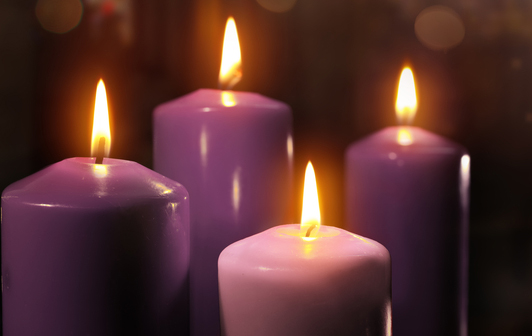This is what makes Advent special for Christians: the recognition that Christmas is not just “the birthday of Jesus,” but a celebration of his coming into our world today, here and now. How does he come into the world today? Jesus is “born”—becomes physically tangible—through the celebration of the sacraments. It is by eating the Eucharist, washing in the waters of Baptism, being anointed with the oil of Confirmation and so on, that Jesus’ friends become part of the living Body of Christ (the Church) in the world today. For Catholics, then, every celebration of the Eucharist and the other sacraments is like a little Christmas.
During Advent, Christians prepare for this here-and-now coming of Christ by remembering the long years during which Israel waited for the coming of the Messiah, and by looking forward to the final coming of Christ at the end of time. You will hear both themes reflected in the Church’s readings during Advent.
Here are some practical ways that you can prepare to fully celebrate Advent with your kids. Remember, you don’t have to do it all—just choose a few practices to focus on, and see whether they work for your family.
1. Get or make an Advent wreath
The Advent wreath is one of the most familiar and beloved symbols of Advent. Children love lighting the candles, one each week, as a way of counting down the time until Christmas. Darkening the room and praying by candlelight is also a good way to signal to children that we are entering a very special time,
Advent wreaths usually consist of four candles, three violet and one rose, set in a circular wreath (usually made of evergreen branches). One candle is lit for each Sunday of Advent, with the rose candle being lit on the third Sunday (Gaudete Sunday, from the Latin word for “rejoice”). The violet (or purple) candles represent the penance and sacrifice we undertake to help us prepare for the Lord’s coming at Christmas; the rose candle represents the rejoicing of the faithful at the mid-point of Advent. You can purchase Advent wreaths inexpensively; on the other hand, you might find it more fun to make your own.
You can get free prayer materials to use with your Advent wreath from your parish or from the USCCB Advent website. For many more Advent wreath resources, including links to instructions about how to make one, see Light Up Your Advent with These Advent Wreath Ideas.
2. Bless your Advent wreath
On the first Sunday of Advent, be sure to bless your Advent wreath. Use the blessing provided by the U.S. Catholic bishops at their Advent website.
3. Set up a nativity scene
St. Francis had the brilliant idea to create a scene depicting the nativity of Jesus as a way of teaching the people about the meaning of the Incarnation. Displaying a nativity scene (or manger set) in your home during Advent is a great way to remind everyone (not just little kids) about the true meaning of Christmas: the Creator of the universe entering into creation in order to save it. Here are a few ideas for ways to use your nativity scene:
- Setting up the manger is a great activity for the Friday or Saturday after Thanksgiving. When you set it up, don’t put out the baby Jesus; save that until Christmas Eve (or morning).
- Some families like to have the baby Jesus appear in the manger overnight on Christmas Eve. That way, everyone can stop by the manger to greet the baby Jesus before opening presents.
- You can also wait to put out the wise men. When you do put them out (perhaps on Gaudate Sunday, the third Sunday of Advent), consider placing them someplace far away from the manger, moving them a little bit closer every day until they “arrive” on the Feast of the Epiphany.
- Another custom is to cut up small snips of paper to be “hay” for the baby Jesus; place the hay in a little bowl or cup near the manger. Every time your younger children do a good deed, they can place a piece of the hay in the baby Jesus’ bed to get it ready for his arrival.
- Use the manger set to tell the Christmas story to little children as the story unfolds in the Sunday and weekday readings throughout Advent. For example, hold the Mary and angel figure as you paraphrase the reading about the Annunciation.
- Manger sets can be pricey—and fragile. Consider buying a nativity set second-hand, or make your own. Here’s a video about how to make a peg-doll nativity set:
4. Bless your nativity scene
Once you’ve set up your nativity set, bless it during your family prayer time using the Blessing of a Christmas Manger or Nativity Scene provided by the U.S. bishops.
5. Have an Advent Tree
Do you set up your Christmas tree the weekend after Thanksgiving, then take it down on New Year’s Day? This year, try waiting to fully decorate your tree until Christmas Eve. Instead, let your bare tree be an “Advent Tree,” a symbol of our waiting for the coming of Christ.
This doesn’t mean that you have to leave the tree completely bare. You can put on a single string of lights during the first week of Advent, then add another string of lights every Sunday until Christmas. Some families also add one decoration per day during Advent. Other families hang Jesse Tree ornaments on their Advent Tree (see below).
If you go this route, you may also want to keep your Christmas tree up for the whole Christmas season, which ends at the Feast of the Baptism of the Lord (the weekend after Epiphany, in mid-January).
6. Make a Jesse tree
Another Christmas-tree alternative during Advent is to make a Jesse tree, which is a tree decorated with ornaments based on symbols of Old Testament events preparing for the coming of Christ. It might include an ark or rainbow to depict Noah and the flood, for instance, and a ladder to represent Jacob’s ladder.
7. Keep an Advent calendar
An Advent calendar, as the name implies, marks off the days of Advent. Some elaborate Advent calendars have a door to be opened for each day, with candy or a prize behind each door. You can purchase these at your local retailer or online.
If you want to observe the spirit of Advent, though, look for a more spiritually focused Advent calendar. The U.S. Catholic bishops provide an Advent calendar on their website, with activity suggestions for each day.
Another simple way to do an Advent calendar that builds on your Advent Tree is to make a decorative paper chain: every day, your kids can add a single link to the chain. You can have them decorate the link with a Jesse Tree symbol, or write a phrase from the day’s Scripture readings on it…the possibilities are endless.
8. Look ahead to the feasts and celebrations of Advent
There are quite a few important (and fun) feasts and celebrations during the Advent season. Look ahead to see what’s coming up so you can plan small celebrations throughout the season. Here’s what’s coming up:
December 3 | Feast of St. Francis Xavier
Francis Xavier was one of the founding members of the Society of Jesus (Jesuits), and led an extensive mission to proclaim Christianity throughout Asia.
December 6 | Feast of St. Nicholas
Saint Nicholas, a bishop who lived during the third century, is the original “Santa Claus.” On the feast of St. Nicholas, children leave their shoes by the door for St. Nicholas to fill with candy (often foil-wrapped chocolate coins). This tradition recalls the story of how St. Nicholas secretly provided the dowry for young maidens so they could get married.
This feast day is also a good opportunity to tell kids the true story of “Santa Claus.” Find out five ways to celebrate the feast with your kids. Then head over to the Saint Nicholas Center, which has every imaginable resource on the original St. Nicholas.
December 8 | Solemnity of the Immaculate Conception
The Solemnity of the Immaculate Conception, a holy day of obligation in the United States, commemorates the immaculate (“stainless”) conception of the Blessed Virgin Mary. It is not about Mary’s conception of Jesus. Find out how to explain the Immaculate Conception to your kids.
December 9 | Feast of St. Juan Diego
St. Juan Diego is the peasant to whom the Virgin Mary appeared as Our Lady of Guadalupe.
December 12 | Feast of Our Lady of Guadalupe
On the morning of December 9, 1531, the Virgin Mary appeared to a Mexican peasant named Juan Diego at a place called the Hill of Tepeyac (now part of Mexico City). Speaking to him in his native Nahuatl language, Mary identified herself as the “mother of the very true deity” and asked for a church to be built at that site in her honor. Juan Diego finally convinced skeptical Church authorities of the truth of the message by producing an armful of out-of-season roses from the folds of his tilma (a simple outer garment); an image of the Virgin Mary as a young, pregnant native woman miraculously appeared on the tilma as well. The image has been preserved to this day, and draws millions of pilgrims every year. Find out how to celebrate the feast of Our Lady of Guadalupe with your kids.
December 13 | Feast of St. Lucy
Lucia of Syracuse (283–304) was a young Christian martyr. Later accounts of her martyrdom included a story about her eyes getting gouged out; that, along with the date of her feast, led to the celebration of her feast as a festival of light, especially in Scandinavian cultures. There, a young girl dressed in a white dress and a red sash (as the symbol of martyrdom) carries palms and wears a crown or wreath of candles on her head. It is said that to vividly celebrate St. Lucy’s Day will help you survive the long, dark winter days.
December 14 | Feast of St. John of the Cross
John of the Cross, together with St. Teresa of Avila, reformed the Carmelite order in the sixteenth century. He is also well-known for his spiritual writings, which had an enormous impact on the development of the Catholic contemplative tradition.
December 16 | Las Posadas
Las Posadas is a nine-day celebration that had its origins in Spain, but is now widely practiced in Latin America. Posadas means “lodging”; the celebration is chiefly a re-enactment of Mary and Joseph’s search for lodging in Bethlehem, and underlines the Christian importance of offering hospitality.
You can find out more about Las Posadas at Wikipedia.
December 16 | Christmas Novena
Pray a special Christmas Novena beginning nine days before Christmas.
December 17 | O Antiphons
The O Antiphons are sung or recited during the last seven days of Advent (from December 17 through December 23) as part of the Liturgy of Hours. Each hymn begins with the interjection “O” followed by a title for Christ, e.g., O Wisdom, O Lord, O Root of Jesse, O Key of David, O Dayspring, O King of Nations, O God-with-Us. You can find the O Antiphons online.



